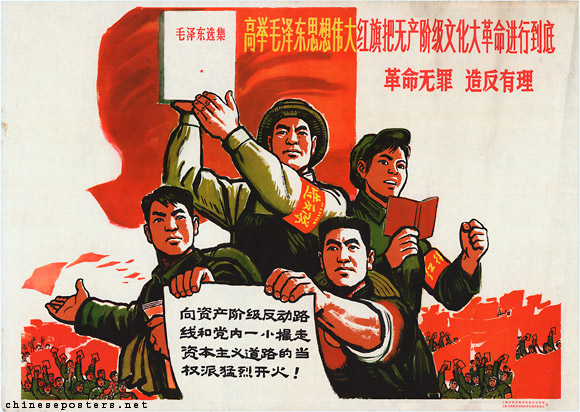Beginning in 1966, China witnessed an extraordinary explosion of violence across the perpetrated by young middle and high school students. Teachers, intellectuals and other “enemies of the state” were dragged from their homes, savagely beaten in the streets, tortured, and summarily executed by these children. This chaos unfolded with the blessing of Mao who exploited it to seize power after being pushed aside following the tragic Great Leap Forward that caused tens of millions of people to starve to death. His deliberate intervention in the movement helped shape the identity of the Red Guards, validating their appropriation of the Red Army uniform and the militaristic adherence to Mao Zedong Thought.
To understand the significance on Mao’s influence on the sartorial choices of the Red Guards, one needs simply to examine propaganda prior to his receiving the Red Guards in Tiananmen Square.

“Criticize the old world and build a new world with Mao Zedong Thought as a weapon.” Sept, 1966. Reproduced from chineseposters.net
In this poster, the title reads “Criticize the old world and build a new world with Mao Zedong Thought as a weapon” and it is from September, 1966. In the center of the poster is a young man who is wearing a green People’s Liberation Army jacket with the sleeves rolled up with blue pants and the typical red armband and carries Mao’s Little Red Book. Behind him are young people in varying outfits: some are wearing completely PLA uniforms, while others are wearing only partial uniforms like the green jacket without matching pants; others are wearing blue Mao PLA suits or plain shirts and pants. Behind them are large red banners.
The discord between this image and the legions of identically dressed youngsters clad in PLA uniforms can be resolved by noting that this image was produced in September, 1966. Mao only appeared clad in his olive PLA uniform on the gates of Tiananmen Square on August 18, 1966. This early in the movement, it is very possible that the Red Guards as a whole had not coalesced around that form of dress even if the elite members from Tsinghua already dressed that way. Instead, careful analysis of the image reveals that they conceived of two unifying symbols: Mao’s Little Red Book and the red armband. Despite their being dressed differently, each person holds a Little Red Book. More importantly, the artist has configured each person so that the book is over their heart. Subtly, the artist wishes to state that what defines the Red Guards at this moment in time is not what they wear, but that they take Mao’s words to heart and always carry his words with them.
yes, the poster intends to address that mao’s little red book, thereby mao’s thoughts, is the leading rhetoric for the CR.

“Hold high the great red banner of Mao Zedong to wage the Great Proletarian Cultural Revolution to the end”, 1967, reproduced from chineseposters.net
Less than a year later, the Party produced a poster titled “Hold high the great red banner of Mao Zedong thought to wage the Great Proletarian Cultural Revolution to the end – Revolution is no crime, to rebel is justified.” The poster prominently features two red guards in the center wearing the characteristic olive military uniforms of the PLA. The Red Guards holds a copy of Mao’s Little Red Book in her hands and wears an armband on her left arm. Between them are two peasants who are also wearing red arm bands, as well as overalls and sun hats. Behind them are legions of Red Guards wearing the military uniforms and holding Mao’s Little Red Book high above their heads.
workers, peasants, soldiers, and red guards are the social political subjects of the poster, thereby the focal point.
One must note the significance of placing two peasants between the two Red Guards. The Cultural Revolution and its Red Guards were predominantly an urban phenomenon in China. To place two peasants between them symbolizes the unity of the two important segments of Chinese society. Furthermore, this is supported by the peasants’ wearing of the red armband. Not only their location in the image, but the sartorial choices made by the artist are intended to illustrate ideological harmony between the two. Lastly, one should emphasize the sartorial uniformity of the Red Guards in the background. When comparing it to the preceding image, the Red Guards in the background are all wearing olive military uniforms. Contextualizing this difference with the date disparity between the two – 1966 to 1967 – illustrates that the movement quickly coalesced around the olive green military uniform with the red armband as the proper uniform in just a few months. Perhaps this might be due to the influence of Mao’s appearing at Tiananmen Square several times in the span of a few months wearing this exact uniform. Their desire to emulate his thought might have been augmented by their desire to emulate his person.
